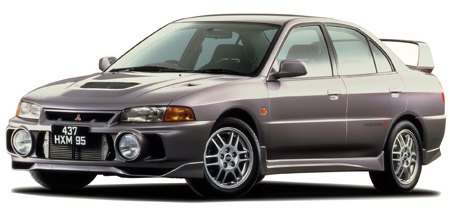The Lancer platform was completely changed in 1996, and along with it,
the Evolution, which had become extremely popular throughout the world.
The engine and transaxle was rotated 180° to better balance the weight
and eliminate
torque steer.
There were two versions available, The RS and GSR. The RS version was
produced as a competition car with a limited-slip front differential and
a friction type LSD at the rear. It also came with GLX seats and a
choice of either 16" or 17" OZ light weight racing wheels. The RS also
had wind up windows, optional air conditioning in some models, and a few
extra brace bars to strengthen the chassis, one behind the front grill
and the other across the boot floor. The RS also had thinner body panels
and glass. The GSR and the RS shared a new twin scroll turbocharger
which helped to improve response and increase power to 280 PS (206 kW;
276 hp) at 6,500 rpm and 330 N·m (243 lb·ft) and torque at 4,000 rpm.
Mitsubishi's new
Active Yaw Control appeared as a factory option on the GSR model, which used steering, throttle input sensors and
g
sensors to computer-hydraulically control torque split individually to
the rear wheels and as a result the 10000 Evolution IVs produced all
sold quickly. The Evolution IV can be distinguished by its two large fog
lights in the front bumper (option on RS version), and the newly
designed tail lights on the rear, which became a standard design to
Evolution V, which would become yet another trademark of the Evolution
series. This new generation was slightly heavier than previous Evos—the
GSR in particular due to the added technology systems—but to counter
this the car produced even more power—the weight of the RS being
1,260 kg (2,778 lb) and the GSR being 1,345 kg (2,965 lb). Much of the
technical improvements for this generation were also used in the second
generation
Mitsubishi RVR sold only in Japan.

| Overview |
|---|
| Production |
August 1996 – January 1998 |
| Body and chassis |
| Platform |
CN9A |
| Powertrain |
| Transmission |
5-speed manual |
| Dimensions |
| Wheelbase |
2,510 mm (98.8 in) |
| Length |
4,330 mm (170.5 in) |
| Width |
1,690 mm (66.5 in) |
| Height |
1,415 mm (55.7 in) |
| Curb weight |
1,260–1,350 kg (2,778–2,976 lb) |
Evo IV from Aug 1996 was
based on the body of new generation Lancer. Apart from the stronger
chassis, a lot effort was made to the engine and drivetrain. Racing
camshaft, lighter pistons, improved induction and exhaust yielded
another 10 hp and more important, 33 lbft of torque. A twin-scroll
turbo reduced exhaust interferences, improving low-end response and
cutting turbo lag. 0-60 mph now dropped to 4.8 seconds. Larger brakes
were adopted to match the increased performance. AYC Active Yaw Control
made its debut on the Evo IV. It was actually an active rear
differential, helping the car to regulate understeer and oversteer.
Externally, this car looked almost a rally car with its monstrous-size
intakes and large fog lamps, but people liked it! 9,000 cars were built
and all sold quickly.



No comments:
Post a Comment